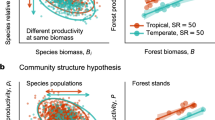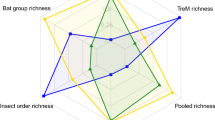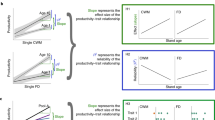Abstract
Higher levels of taxonomic and evolutionary diversity are expected to maximize ecosystem function, yet their relative importance in driving variation in ecosystem function at large scales in diverse forests is unknown. Using 90 inventory plots across intact, lowland, terra firme, Amazonian forests and a new phylogeny including 526 angiosperm genera, we investigated the association between taxonomic and evolutionary metrics of diversity and two key measures of ecosystem function: aboveground wood productivity and biomass storage. While taxonomic and phylogenetic diversity were not important predictors of variation in biomass, both emerged as independent predictors of wood productivity. Amazon forests that contain greater evolutionary diversity and a higher proportion of rare species have higher productivity. While climatic and edaphic variables are together the strongest predictors of productivity, our results show that the evolutionary diversity of tree species in diverse forest stands also influences productivity. As our models accounted for wood density and tree size, they also suggest that additional, unstudied, evolutionarily correlated traits have significant effects on ecosystem function in tropical forests. Overall, our pan-Amazonian analysis shows that greater phylogenetic diversity translates into higher levels of ecosystem function: tropical forest communities with more distantly related taxa have greater wood productivity.
This is a preview of subscription content, access via your institution
Access options
Access Nature and 54 other Nature Portfolio journals
Get Nature+, our best-value online-access subscription
$29.99 / 30 days
cancel any time
Subscribe to this journal
Receive 12 digital issues and online access to articles
$119.00 per year
only $9.92 per issue
Buy this article
- Purchase on Springer Link
- Instant access to full article PDF
Prices may be subject to local taxes which are calculated during checkout



Similar content being viewed by others
Data availability
The permanently archived data package of the plot-level diversity, aboveground biomass, wood productivity and genus-level phylogeny are available from https://www.forestplots.net/en/publications#data.
References
Maherali, H. & Klironomos, J. N. Influence of phylogeny on fungal community assembly and ecosystem functioning. Science 316, 1746–1749 (2007).
Cadotte, M. W. Experimental evidence that evolutionarily diverse assemblages result in higher productivity. Proc. Natl Acad. Sci. USA 110, 8996–9000 (2013).
Cadotte, M. W., Cavender-Bares, J., Tilman, D. & Oakley, T. H. Using phylogenetic, functional and trait diversity to understand patterns of plant community productivity. PLoS ONE 4, e5695 (2009).
Cadotte, M. W., Cardinale, B. J. & Oakley, T. H. Evolutionary history and the effect of biodiversity on plant productivity. Proc. Natl Acad. Sci. USA 105, 17012–17017 (2008).
Srivastava, D. S., Cadotte, M. W., Macdonald, A. A. M., Marushia, R. G. & Mirotchnick, N. Phylogenetic diversity and the functioning of ecosystems. Ecol. Lett. 15, 637–648 (2012).
Cadotte, M. W. Phylogenetic diversity and productivity: gauging interpretations from experiments that do not manipulate phylogenetic diversity. Funct. Ecol. 29, 1603–1606 (2015).
Cadotte, M. W. Phylogenetic diversity–ecosystem function relationships are insensitive to phylogenetic edge lengths. Funct. Ecol. 29, 718–723 (2015).
Davies, T. J., Urban, M. C., Rayfield, B., Cadotte, M. W. & Peres-Neto, P. R. Deconstructing the relationships between phylogenetic diversity and ecology: a case study on ecosystem functioning. Ecology 97, 2212–2222 (2016).
Venail, P. et al. Species richness, but not phylogenetic diversity, influences community biomass production and temporal stability in a re-examination of 16 grassland biodiversity studies. Funct. Ecol. 29, 615–626 (2015).
Coelho de Souza, F. et al. Evolutionary heritage influences Amazon tree ecology. Proc. R. Soc. B Biol. Sci. 283, 20161587 (2016).
Webb, C. O., Ackerly, D. D., Mcpeek, M. A. & Donoghue, M. J. Phylogenies and community ecology. Annu. Rev. Ecol. Syst. 33, 475–505 (2002).
Webb, C. O. & Losos, A. E. J. B. Exploring the phylogenetic structure of ecological communities: an example for rain forest trees. Am. Nat. 156, 145–155 (2000).
Chave, J. et al. Regional and phylogenetic variation of wood density across 2456 neotropical tree species. Ecol. Appl. 16, 2356–2367 (2006).
Baraloto, C. et al. Decoupled leaf and stem economics in rain forest trees. Ecol. Lett. 13, 1338–1347 (2010).
Fauset, S. et al. Hyperdominance in Amazonian forest carbon cycling. Nat. Commun. 6, 6857 (2015).
Faith, D. P. Conservation evaluation and phylogenetic diversity. Biol. Conserv. 61, 1–10 (1992).
Tucker, C. M. et al. A guide to phylogenetic metrics for conservation, community ecology and macroecology. Biol. Rev. 92, 698–715 (2016).
Cadotte, M., Albert, C. H. & Walker, S. C. The ecology of differences: assessing community assembly with trait and evolutionary distances. Ecol. Lett. 16, 1234–1244 (2013).
Swenson, N. G. Phylogenetic resolution and quantifying the phylogenetic diversity and dispersion of communities. PLoS ONE 4, e4390 (2009).
Honorio Coronado, E. N. et al. Phylogenetic diversity of Amazonian tree communities. Divers. Distrib. 21, 1295–1307 (2015).
Ter Steege, H. et al. Hyperdominance in the Amazonian tree flora. Science 342, 1243092 (2013).
Beer, C. et al. Terrestrial gross carbon dioxide uptake: global distribution and covariation with climate. Science 329, 834–838 (2010).
Malhi, Y. et al. The regional variation of aboveground live biomass in old-growth Amazonian forests. Glob. Change Biol. 12, 1107–1138 (2006).
Forest, F. et al. Preserving the evolutionary potential of floras in biodiversity hotspots. Nature 445, 757–760 (2007).
Quesada, C. A. et al. Basin-wide variations in Amazon forest structure and function are mediated by both soils and climate. Biogeosciences 9, 2203–2246 (2012).
Sullivan, M. J. P. et al. Diversity and carbon storage across the tropical forest biome. Sci. Rep. 7, 39102 (2017).
Hijmans, R. J., Cameron, S. E., Parra, J. L., Jones, P. G. & Jarvis, A. Very high resolution interpolated climate surfaces for global land areas. Int. J. Climatol. 25, 1965–1978 (2005).
Quesada, C. A. et al. Variations in chemical and physical properties of Amazon forest soils in relation to their genesis. Biogeosciences 7, 1515–1541 (2010).
Chave, J. et al. Towards a worldwide wood economics spectrum. Ecol. Lett. 12, 351–366 (2009).
Voskamp, A., Baker, D. J., Stephens, P. A., Valdes, P. J. & Willis, S. G. Global patterns in the divergence between phylogenetic diversity and species richness in terrestrial birds. J. Biogeogr. 44, 709–721 (2017).
Dexter, K. & Chave, J. Evolutionary patterns of range size, abundance and species richness in Amazonian angiosperm trees. PeerJ 4, e2402 (2016).
Baraloto, C. et al. Using functional traits and phylogenetic trees to examine the assembly of tropical tree communities. J. Ecol. 100, 690–701 (2012).
Magurran, A. E. Measuring Biological Diversity (Blackwell Science, 2004).
Reich, P. B. Key canopy traits drive forest productivity. Proc. R. Soc. B Biol. Sci. 279, 2128–2134 (2012).
Williams, L. J., Paquette, A., Cavender-Bares, J., Messier, C. & Reich, P. B. Spatial complementarity in tree crowns explains overyielding in species mixtures. Nat. Ecol. Evol. 1, 0063 (2017).
Jucker, T., Bouriaud, O. & Coomes, D. A. Crown plasticity enables trees to optimize canopy packing in mixed-species forests. Funct. Ecol. 29, 1078–1086 (2015).
Pretzsch, H. Canopy space filling and tree crown morphology in mixed-species stands compared with monocultures. For. Ecol. Manage. 327, 251–264 (2014).
Goodman, R. C., Phillips, O. L. & Baker, T. R. The importance of crown dimensions to improve tropical tree biomass estimates. Ecol. Appl. 24, 680–698 (2014).
Goodman, R. C., Phillips, O. L. & Baker, T. R. Dryad Data from: The importance of crown dimensions to improve tropical tree biomass estimates. Dryad Digital Repository https://doi.org/10.5061/dryad.p281g (2013).
Parker, I. M. et al. Phylogenetic structure and host abundance drive disease pressure in communities. Nature 520, 542–544 (2015).
Gilbert, G. S. & Parker, I. M. The evolutionary ecology of plant disease: a phylogenetic perspective. Annu. Rev. Phytopathol. 54, 549–578 (2016).
Fine, P. V., Mesones, I. & Coley, P. D. Herbivores promote habitat specialization by trees in Amazonian forests. Science 305, 663–665 (2004).
Forrister, D. L., Endara, M.-J., Younkin, G. C., Coley, P. D. & Kursar, T. A. Herbivores as drivers of negative density dependence in tropical forest saplings. Science 363, 1213–1216 (2019).
Eichenberg, D. et al. Impacts of species richness on productivity in a large-scale subtropical forest experiment. Science 362, 80–83 (2018).
Satdichanh, M. et al. Phylogenetic diversity correlated with above-ground biomass production during forest succession: evidence from tropical forests in Southeast Asia. J. Ecol. 107, 1419–1432 (2018).
Cavanaugh, K. C. et al. Carbon storage in tropical forests correlates with taxonomic diversity and functional dominance on a global scale. Glob. Ecol. Biogeogr. 23, 563–573 (2014).
Poorter, L. et al. Diversity enhances carbon storage in tropical forests. Glob. Ecol. Biogeogr. 24, 1314–1328 (2015).
Sande, M. T. et al. Biodiversity in species, traits, and structure determines carbon stocks and uptake in tropical forests. Biotropica 49, 593–603 (2017).
Johnson, M. O. et al. Variation in stem mortality rates determines patterns of above-ground biomass in Amazonian forests: implications for dynamic global vegetation models. Glob. Change Biol. 22, 3996–4013 (2016).
Chao, K. J. et al. Growth and wood density predict tree mortality in Amazon forests. J. Ecol. 96, 281–292 (2008).
Lopez-Gonzalez, G., Lewis, S. L., Burkitt, M. & Phillips, O. L. ForestPlots.net: a web application and research tool to manage and analyse tropical forest plot data. J. Veg. Sci. 22, 610–613 (2011).
Lopez-Gonzalez G., Simon L. L., Mark B., Baker P. J. & Oliver L. P. ForestPlots.net (2009); www.forestplots.net
Forrestel, E. J. et al. Different clades and traits yield similar grassland functional responses. Proc. Natl Acad. Sci. USA 114, 705–710 (2017).
Dexter, K. G. et al. Dispersal assembly of rain forest tree communities across the Amazon basin. Proc. Natl Acad. Sci. USA 114, 2645–2650 (2017).
Boyle, B. et al. The taxonomic name resolution service: an online tool for automated standardization of plant names. BMC Bioinformatics 14, 16 (2013).
Gonzalez, M. A. et al. Identification of Amazonian trees with DNA barcodes. PLoS ONE 4, e7483 (2009).
Lewis, S. L. et al. Tropical forest tree mortality, recruitment and turnover rates: calculation, interpretation and comparison when census intervals vary. J. Ecol. 92, 929–944 (2004).
Talbot, J. et al. Methods to estimate aboveground wood productivity from long-term forest inventory plots. For. Ecol. Manage. 320, 30–38 (2014).
Lewis, S. L. et al. Increasing carbon storage in intact African tropical forests. Nature 457, 1003–1006 (2009).
Chave, J. et al. Improved allometric models to estimate the aboveground biomass of tropical trees. Glob. Change Biol. 20, 3177–3190 (2014).
Zanne, A. E. et al. Dryad Data from: Towards a worldwide wood economics spectrum. Dryad Digital Repository https://doi.org/10.5061/dryad.234 (2009).
Feldpausch, T. R. et al. Height–diameter allometry of tropical forest trees. Biogeosciences 8, 1081–1106 (2011).
Benjamini, Y. & Hochberg, Y. Controlling the false discovery rate: a practical and powerful approach to multiple testing. J. R. Stat. Soc. Ser. B 57, 289–300 (1995).
Ter Steege, H. et al. Continental-scale patterns of canopy tree composition and function across Amazonia. Nature 443, 444–447 (2006).
Kutner, M., Nachtsheim, C., Neter, J. & Li, W. Applied Linear Statistical Models (McGraw-Hill/Irwin, 2004).
Kim, S. ppcor: An R package for a fast calculation to semi-partial correlation coefficients. Commun. Stat. Appl. Methods 22, 665–674 (2015).
R. Development Core Team R: A Language and Environment for Statistical Computing (R Foundation for Statistical Computing, 2014).
Dixon, P. VEGAN, a package of R functions for community ecology. J. Veg. Sci. 14, 927–930 (2009).
Kembel, S. W. et al. Picante: R tools for integrating phylogenies and ecology. Bioinformatics 26, 1463–1464 (2010).
Lopez-Gonzalez, G., Sullivan, M. & Baker, T. BiomasaFP: tools for analysing data downloaded from ForestPlots.net. R package version 1.1 https://rdrr.io/github/ForestPlots/BiomasaFP/ (2015).
Pinheiro, J. et al. nlme: linear and nonlinear mixed effects models. R package version 3.1-128 https://cran.r-project.org/web/packages/nlme/index.html (2016).
Eva, H. D. et al. The land cover map for South America in the year 2000. GLC2000 Database (European Commission, Joint Research Centre, 2003); https://forobs.jrc.ec.europa.eu/products/glc2000/glc2000.php
Acknowledgements
This paper is a product of the project ‘Niche Evolution of South American Trees’ (funded by NERC; NE/I028122/1), RAINFOR (the Amazon Forest Inventory Network) and ForestPlots.net (www.ForestPlots.net). Phylogenetic data were generated by the Niche Evolution of South American Trees project; forest inventory data were generated by the RAINFOR network and curated by ForestPlots.net. RAINFOR and ForestPlots.net have been supported by the Gordon and Betty Moore Foundation, the European Union’s Seventh Framework Programme projects 283080 (GEOCARBON) and 282664 (AMAZALERT), ERC grant ‘Tropical Forests in the Changing Earth System’, Natural Environment Research Council Urgency, Consortium and Standard grants ‘AMAZONICA’ (NE/F005806/1), ‘TROBIT’ (NE/D005590/1) and ‘Niche Evolution of South American Trees’ (NE/I028122/1), and ‘BIO-RED’ (NE/N012542/1). F.C.d.S. was supported by a PhD scholarship from the Coordination for the Improvement of Higher Education Personnel (Brazil; 117913-6). K.G.D. was supported by a Leverhulme International Academic Fellowship. O.L.P. was supported by an ERC Advanced Grant and is a Royal Society Wolfson Research Merit Award holder. R.T.B. acknowledges support from a Leverhulme Trust Research Fellowship (RF-2015-653). This paper is 772 in the Technical Series of the Biological Dynamics of Forest Fragments Project (BDFFP-INPA/STRI). We thank J. Lloyd and C. A. Quesada for comments on the manuscript. J. Lloyd helped conceived the RAINFOR forest census plot network. We also acknowledge A. Clark for laboratory work to generate new DNA sequences.
Author information
Authors and Affiliations
Contributions
F.C.d.S., R.T.B. and K.G.D. conceived the study. F.C.d.S., R.T.B., O.L.P. and K.G.D. designed the study. F.C.d.S., K.G.D. and R.T.B. produced the phylogeny. F.C.d.S. analysed the data and wrote the paper. All co-authors collected field data or managed data. O.L.P. and Y.M. conceived the RAINFOR forest census plot network. K.G.D., O.L.P., R.T.P., D.N., M.J.P.S., E.Á.-D., A.Alves, I.A., A.Andrade, L.E.O.C.A., A.A.-M., E.J.M.M.A., L.A., G.A.A.C., O.B., C.B., J.G.B., R.G.A.B., R.J.W.B., F.B., J.L.C.C., W.C., J.C., A.C., J.A.C., F.C.-V., A.L.d.C., P.B.d.C., A.D.F., T.R.F., D.R.G., E.G., R.C.G., M.G., R.H., N.H., E.N.H.C., E.J.-R., T.J.K., S.L., W.F.L., G.L.-G., T.E.L., Y.M., B.S.M., B.H.M.-J., C.M., A.M.-M., D.A.N., P.N.V., M.C.P.M., G.C.P., J.J.P., N.C.A.P., L.P., A.P., F.R., A.Roopsind, A.Rudas, R.P.S., N.S., M.S., J.Singh, J.Stropp, H.t.S., J.T., R.T.-C., R.K.U., R.V.V., I.C.-V., S.A.V., V.A.V., R.J.Z. and R.T.B. commented and/or approved the manuscript.
Corresponding author
Ethics declarations
Competing interests
The authors declare no competing interests.
Additional information
Publisher’s note Springer Nature remains neutral with regard to jurisdictional claims in published maps and institutional affiliations.
Supplementary information
Supplementary Information
Supplementary Tables 1–6, Figs. 1–12, methods, results, discussion and Appendices 1–5.
Rights and permissions
About this article
Cite this article
Coelho de Souza, F., Dexter, K.G., Phillips, O.L. et al. Evolutionary diversity is associated with wood productivity in Amazonian forests. Nat Ecol Evol 3, 1754–1761 (2019). https://doi.org/10.1038/s41559-019-1007-y
Received:
Accepted:
Published:
Issue Date:
DOI: https://doi.org/10.1038/s41559-019-1007-y
This article is cited by
-
Global conservation status of the jawed vertebrate Tree of Life
Nature Communications (2024)
-
Ecoinformatics for conservation biology
Nature Ecology & Evolution (2022)
-
The contribution of environmental and dispersal filters on phylogenetic and taxonomic beta diversity patterns in Amazonian tree communities
Oecologia (2021)
-
Mature Andean forests as globally important carbon sinks and future carbon refuges
Nature Communications (2021)
-
Amazon tree dominance across forest strata
Nature Ecology & Evolution (2021)



